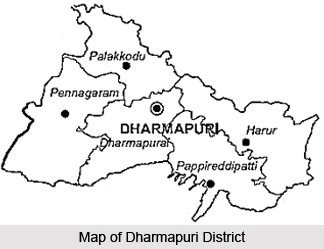 Geography of Dharmapuri district is prone to draught and therefore the draught resistant fruits crops are mainly grown in this district. The district of Dharmapuri came into existence from the 2nd of October 1965, and it is located to the north-western corner of the state of Tamil Nadu and is bounded by the district of Tiruvannamalai and Villupuram to the east, Salem district to the South, Krishnagiri district to the north and Kaveri River to the west. The Dharmapuri district is situated between eleven degree and forty seven minutes and twelve degree and thirty three minutes North latitudes and Seventy seven degree two minutes and seventy eight degree forty minutes East longitudes. The total geographical area of the district of Dharmapuri is 4497.77 square kilometers, which is about 3.46 percent of the state of Tamil Nadu.
Geography of Dharmapuri district is prone to draught and therefore the draught resistant fruits crops are mainly grown in this district. The district of Dharmapuri came into existence from the 2nd of October 1965, and it is located to the north-western corner of the state of Tamil Nadu and is bounded by the district of Tiruvannamalai and Villupuram to the east, Salem district to the South, Krishnagiri district to the north and Kaveri River to the west. The Dharmapuri district is situated between eleven degree and forty seven minutes and twelve degree and thirty three minutes North latitudes and Seventy seven degree two minutes and seventy eight degree forty minutes East longitudes. The total geographical area of the district of Dharmapuri is 4497.77 square kilometers, which is about 3.46 percent of the state of Tamil Nadu.
The climatic condition of this district in the state of Tamil Nadu is generally warm. The hottest period of the year in this district usually falls from the months of March to May and the highest temperature in the Dharmapuri district goes up to thirty eight degree centigrade in the month of April. The climate in this district of the Tamil Nadu state gets cooler in the month of December and it continues so up to the month of February by getting down to a minimum of seventeen degree centigrade in the month of January. The average annual rainfall received by the district of Dharmapuri is 895.56 mm.
The type of soil in this district ranges from black to mixed loam. Red sandy soils are also seen in the Harur taluk. Black and loam soil are there in the Dharmapuri taluk. The soil is generally low in Phosphate and Nitrogen content with no marked variation between taluks. The economy of Dharmapuri district economy is largely agrarian and about seventy percent of the workforce is dependent on agriculture and allied activities. This district is having a sufficient reserve of granite. Good quality black granite is available in Pennagaram, Harur and Palacode blocks of the district. The district of Dharmapuri is usually prone to draught and for this reason several drought resistant perennial crops are grown in this district.






